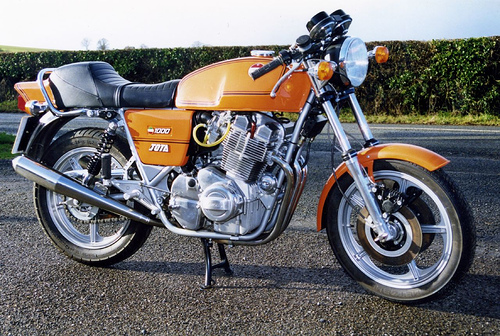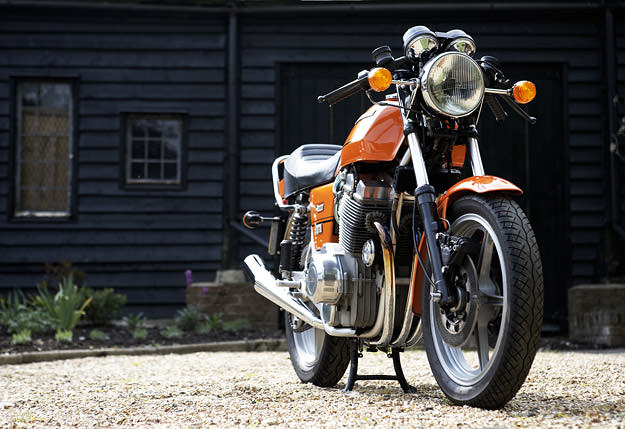Laverda Jota
The Jota’s great asset was engine performance rather than handling, hut the big Laverda cornered well enough to keep it ahead of its rivals on road and track. Finn suspension helped maintain stability in most situations, despite the combined effect of the triple’s size, weight and sheer brute horsepower.
There was no mistaking the appeal of the Laverda Jota. The Italian triple backed up its square-jawed naked style with massive, sometimes intimidating, performance. The Jota was big, brutal, loud and supremely powerful. In the right hands it was simply the fastest thing on two wheels in the late 1970s, as a string of production race victories confirmed.
This most famous of Laverda’s 981cc aircooled triples resulted from a collaboration between the firm from Breganze in northern Italy and Slater Brothers, its British importer. The basis of the Jota was the 3C, itself a potent and handsome machine, which Laverda had created in 1973, essentially by adding an extra cylinder to its existing 650cc parallel twin.
In 1975 brothers Roger and Richard Slater, intending to production race the triple, created a machine they called the 3CE - the 'E’ standing for England - by fitting modifications including a free- breathing exhaust system, rearset footrests and single seat. Meanwhile the factory was developing its own update, the 3CL, which featured cast wheels, triple disc brakes and a tail fairing, and was introduced as a 1976 model.
Combining the two bikes created the machine that the Slaters christened the Jota, after a Spanish dance in three-four time. This time they went further with the engine tuning, fitting the dohc triple with factory endurance race camshafts and high-compression pistons. The result was a substantially increased peak output of 90bhp at 8000rpm, with noise and performance to match.
This was an Italian bike that could live with Japan’s finest for sheer horsepower and speed. The Jota felt rough below about 4000rpm due to its lumpy cams, but came alive above that figure with exhilarating acceleration, a soulful three-cylinder bellow' and a top speed of 140mph (225km/h).
The triple was a demanding bike to ride, its power delivery and sheer speed combining with the unfaired riding position, engine vibration and a heavy clutch to make the rider work hard. In other respects the Laverda was well-equipped, with finish and electrics that were excellent by Italian standards. Handling was generally good, thanks to a strong frame and typically firm Ceriani suspension. But the triple was a tall, heavy machine that required plenty of muscle from its rider, and was prone to weave at high speed. The trio of big, cast iron Brembo discs gave plenty of stopping power, wet or dry.
Mirage - The Fast-Touring Triple
Laverda produced another fine superbike in 1978 by enlarging the 981 cc engine to 1116cc, and fitting higher handlebars plus a larger dual seat to create a slightly softer, touring-oriented model called the 1200. Again, Slater Brothers uprated it with hot cams and a free-breathing exhaust system (compression ratio was left standard) to produce the Mirage. The result was a fast, yet very torquey and versatile, machine. The Laverda factory adopted the Mirage name, although for most markets the bike retained its standard cams and exhaust.
Obvious appeal
Although the Jota was assembled in Breganze (apart from silencers and collector box), the tuned triple was officially a UK-only model. But limited numbers were sold in other markets including America. The price was high, but the appeal was obvious: this was arguably the world’s fastest roadster in 1976. Slaters’ racer Peter Davies supported that claim by dominating the British production race championship.
Laverda modified the triple in subsequent years, notably with a variety of half-fairings, and in 1982 produced a more refined version, the Jota 120. This had a 120-degree firing order, in place of the old 180-degree (one piston up. two down) arrangement. The Jota 120 was much smoother, yet retained the traditional triple character. Although short-lived, it was a fine way to end the famous line.
Lavtrda’s 981ci dohc triple was a potent unit in standard form, and became even more impressive when tuned to Jota specification with factory endurance racing camshafts, plus pistons that raised compression rat from 9:1 to 10:1. The result was a peak output of 90bhp.
The Jota 's ra\ muscular styling was always a big part of its appeal. This bike has the classical early combinatn >n of low-set adjustable handlebars, humped seat and Laverda’s traditional orange paintwork. In the 1980s the triple could be bought with an optional half-fairing that made highspeed cruising a more practical proposition.
Specification Laverda Jota (1976)
- Engine Air-cooled dohc six-valve triple
- Capacity 981 cc (75 x 74mm)
- Maximum power 90bhp @ 8000rpm
- Transmission Five-speed, chain final drive
- Frame Steel twin downtube
- Suspension Telescopic front; twin shocks rear
- Brakes twin discs front; single disc rear
- Weight 5211b (236kg) wet
- Top speed 140mph (225km/h)






















0 comments: